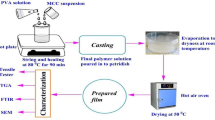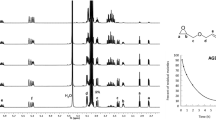Abstract
The investigation of the oxidative thermal destruction of some new cellulose-type fibrous materials, namely poplar down and down of silkweed is described. The latter are characterized by a high content of amorphous components. The components of the fibres, cellulose, holocellulose, hemicelluloses and lignin, separated by extraction, have also been studied. From the experimental data, the compounds isolated from the original material could be classified according to their thermal stabilities. The influence of the molecular structure on the kinetic parameters of the oxidative thermal destruction has also been studied. The activation energies of the single steps of the thermal reaction have been estimated for each compound isolated.
Résumé
On publie une étude sur la destruction thermo-oxydante de quelques matériaux nouveaux du type fibreux ligno-cellulosique, notamment le duvet de peuplier et le duvet d'asclépias. Ce dernier se distingue par une teneur élevée en composants amorphes. On a étudié de même les composants des fibres, la cellulose, l'holocellulose, les hémicelluloses et la lignine, qui avaient été séparés par extraction. Les données expérimentales permettent de classer, selon leurs stabilités thermiques, les composants isolés du matériau initial. L'étude s'étend aussi à l'influence de la structure moléculaire, sur les paramètres cinétiques de la destruction thermo-oxydante. On a estimé, pour chaque composé isolé, les valeurs des énergies d'activation des étapes individuelles de la réaction thermique.
Zusammenfassung
Man verfolgte das Verhalten bei thermo-oxydativer Zersetzung von einigen faserigen lignocelluloseartigen Stoffen, namentlich von Pappelflaumhaar, Seidenpflanze und ihren getrennten Komponenten Cellulose, Lignin, Holocellulose und Hemycellulose. Aufgrund der in verschiedenen Temperaturbereichen registrierten Gewichtsverluste hat man die isolierten Komponenten unter Berücksichtigung der Ausgangsprodukte und in Funktion der thermischen Stabilität klassifiziert. Der Einfluß der molekularen Struktur auf die kinetischen Parameter der thermischen Behandlung wurde diskutiert und Aktivierungsenergiewerte errechnet.
Резюме
Исследована термоок ислительная деструк ция некоторых новых целл юлозноволокнистых материалов, а именно, т ополевого пуха и пуха ваточника (asclepias). Эти материалы характери зуются значительным содержанием аморфного компонент а. Параллельно проведено изучение п редварительно изоли рованных из исходных материалов компонентов: целлюло зы, холоцеллюлозы, гем ицеллюлоз и лигнина. Полученные результа ты позволяют дать кла ссификацию компонентов с точки з рения их термической стаби льности и влияния, ока зываемого надмолекулярной стр уктурой на кинетические параме тры термоокислитель ного распада. Для каждого компонен та произведены колич ественные расчеты величины эне ргии активации характерных ступене й термической реакци и.
Similar content being viewed by others
Bibliographie
S. L. Madorsky, V. E. Hart etSt. Strauss, J. Res. Nat. Bur. Sdts., 56 (1956) 343; 80 (1958) 343.
S. L. Madorsky, Thermal degradation of organic polymers. Interscience publishers, N. Y.-London-Sydney, p. 238–259., 1964.
O. P. Golova, R. G. Krylova, Dokl. Akad. Nauk SSSR, 116 (1957) 419.
O. P. Golova, R. G. Krylova etI. I. Nikolaeva, Vysokomol. Soedin., 1 (1959) 1295.
R. F. Schwenker etR. Pascu, Ind. Eng. Chem., 2 (1957) 83.
J.Honeyman, Fundamental Study of the Pyrolysis of Cotton cellulose to Provide Information Needed for Improvement of Flame Resistant Treatments for Cotton. England, p. 103–104, 1946.
N. Hurduc, I. A. Schneider etCr. Simionescu, Cellul. Chem. Technol., 2 (1968) 569.
N. Hurduc, Dégradation thermique des celluloses greffées. Résumé de la thèse de docteur. Univ. “Al. 1. Cuza” Iassy, 1970.
D. Costa etG. Costa, Chimi. Industria, 33 (1951) 708.
F. G.Domburg et W. N.Sergejewa, Izvest. Akad. Nauk SSSR, (1964) 625.
W. Sandermann etH. Augustin, Holz Roh- Werkstoff, 21 (1963) 256.
W. N. Sergejewa etA. Waiwade, Latv. PSR. Zinatnu Akad. Vest., 9 (1954) 103.
W. N. Sergejewa, Izuchenije protsessow termospada drewesiny, Résumé de la thèse de docteur. O.H.G.N., An. Latv. SSR, Riga, 1962.
R. H.Marchessault, Actes du Symposium International de Grenoble, 1964. Les imprimeries réunies de Chambéry-Editeur.
B.Solomon, G.Rozmarin, A.Biro etCr. Simionescu, Cellul. Chem. Technol., 601 (1967).
Cr. Simionescu et E.Corlâţeanu, Celulozâ si hîrtie, (1968) 265.
Cr. Simionescu etE. Corlâţeanu, Celulozâ şi hîrtie, 2 (1970) 37.
A. Z. Rogovin etN. N. Sorîghin, La chimie de la cellulose et des substances qui l'accompagnent. Bucarest, Ed. Téchnique, 1958.
B. Solomon, G. Rozmarin etCr. Simionescu, Cellul. Chem. Technol. 3 (1958) 291.
E. S. Freeman etB. Carrol, J. Phys. Chem., 62 (1958) 394; J. Polymer Sci., 54 (1961) 259.
Author information
Authors and Affiliations
Rights and permissions
About this article
Cite this article
Corlăţeanu, E., Mihai, E. & Simionescu, C. Destruction thermo-oxydante de certains materiaux fibreux cellulosiques et de leurs composants. Journal of Thermal Analysis 6, 657–672 (1974). https://doi.org/10.1007/BF01911786
Received:
Revised:
Issue Date:
DOI: https://doi.org/10.1007/BF01911786




